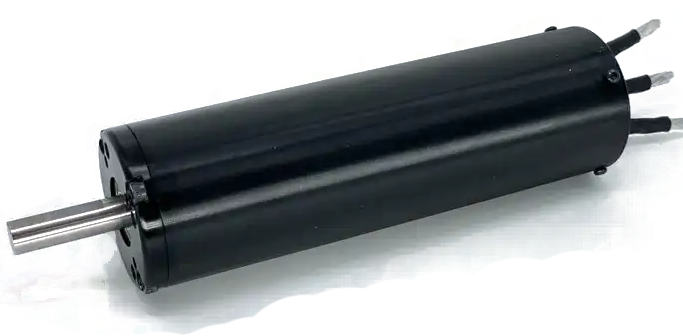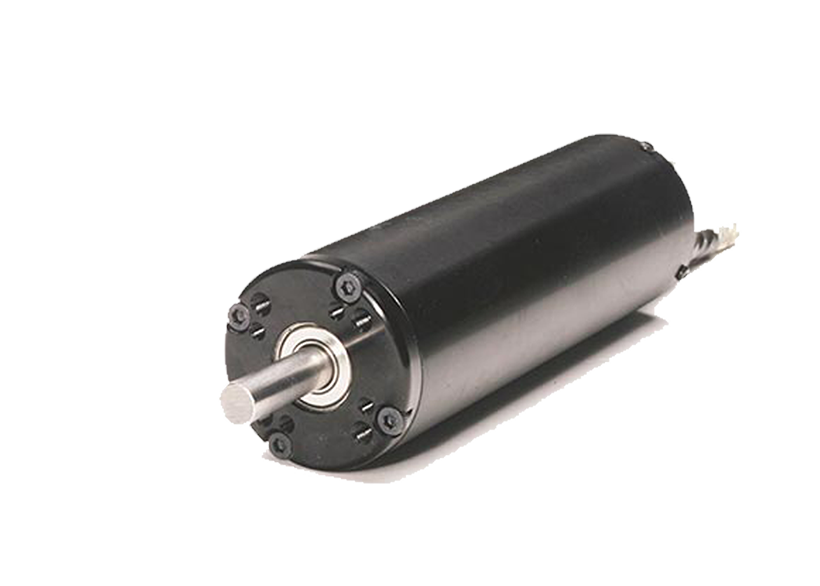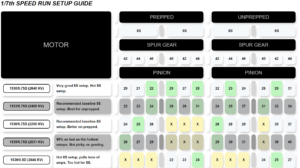MOTORS FOR EXTREME RC SURFACE ACTION
RC DRAG RACING MOTORS
NEURACING 15xx SPEED RUN & DRAG RACING MOTORS
Are you looking for blistering performance for your 1/10th, or for your Limitless, Felony or Infraction? NeuRacing’s RC DRAG RACING MOTORS are your ticket to extreme speed!
1/7th DRAG AND SPEED RUN SETUP GUIDE –
Green setups are recommended. Yellow X setups are not recommended.
WHICH IS THE FASTEST?
1539/ .75D (2031kv) is the longest of the motors and will deliver the most power on 8S depending on gearing. It is heavier and may take more power to simply spin up the rotor.
1539/.5D (3046 KV) is the hottest KV in the longest motor for use with 6S only.
Remember, the other motors in the list may be faster depending on your vehicle setup!
In RC drag racing, the motor is only one part of a system. The motor converts power from a battery to torque at the wheels which then moves the mass of your car forward. Other factors include: optimized gearing, wires, connectors, battery C capability, battery temperature, tires, vehicle weight, front-to back weight distribution and traction.
Check out how we name our RC drag racing motors - It's just a numbering system, the same as we name our motors for healthcare, aerospace, cool electric surfboards, and many other applications - not fancy marketing hype. Understand this and you can easily compare the motors and make the best choice for YOUR setup!
NEURACING MOTOR NAMING SYSTEM -- This is worth reading!
Here's how we name our motors - It's just a numbering system, not fancy marketing hype. Use this to compare the motors.
Let's use the 1530/.75D (2640 KV) as our example. 1530/.75D (2640 KV) should be read as 15 | 30 | .75 | D which runs at 2,640 RPMS per volt.
1530/.75D (2640 KV)
Let's talk about the last part of the code - the Kv. Kv is the voltage constant.* It represents the number of RPMs the motor will spin for each volt applied to the motor by the speed control. A 1,000 KV motor should spin at 10,000 RPMs when 10 volts are applied. A 2,000 KV motor spins at twice the speed of a 1,000KV motor with the same voltage. But this is at NO LOAD. A small 2,000 KV motor may not put out anywhere near the power of a large 1,000 KV motor. You can adjust the connection between the motor and your wheels by varying your gearing ratio to make a low KV motor spin your wheels faster than a high kv motor.
Pro Tip: The KV of a motor is determined by the number of turns of wire around the stator teeth, the length of the motor and the type of wire termination inside the motor.
*Kv in this context does not mean kilovolt. That's written as kV and you'll know it when you see it. We aren't working with kilovolts here!!
1530/.75D (2640 KV)
The first two digits are the motor's internal diameter in inches. 15 = 1.5" inches - so all 15 series are the same diameter.
1530/.75D (2640 KV)
The second two digits are the motor's internal length. 30 is 3.0 inches - so a 1530 is 3 inches long inside and a 1539 is 3.9 inches long inside the case. Longer motors have more power capability and more weight.
1530/.75D (2640 KV)
The 3rd set of digits is the number of times the internal wires are wrapped around the stator teeth. You may be familiar with the old brushed motor term of "turns." More turns means lower Kv. So 1530/.75D has .75 wraps of the wire inside the motor around the steel teeth of the stator.
1530/.75D (2640 KV)
The final letter refers to the internal connection of the 3 motor wires. D = Delta, the Greek letter for D that looks like a triangle. The other option is Y, and the Y wind looks like a letter Y inside. A Delta motor will spin 1.8 times the kv of a Y motor with the same number of turns. Change the turns in a Y motor and it will spin just as fast as a Delta with nearly identical performance.
NOTE: This system applies to the NEUMOTORS INRUNNERS. OUTRUNNERS are the same format, but they are in metric units (MM).
WHICH IS BETTER, DELTA OR Y?
WILL TIMING ADVANCE MAKE ME KING OF THE STRIP?
"But what about timing advance?" you ask. Timing advance in your ESC settings can slightly increase the KV of a Y wind motor. This only works with Y wind motors, and it is only a 2 to 3% increase in RPM. This comes at a dramatic increase in heat inside the motor. Timing advance is the last option behind proper choice of Kv, optimizing gearing, wiring, connectors, battery C capability*, battery temperature, tires, overall weight, front-to-back weight distribution and track surface.
"But what about timing advance on a D wind motor?" Set the ESC to LOW or auto mode. Timing makes no performance improvement in the system. Changing timing for a D wind motor will negatively affect performance.
If you want a higher KV motor, just order a higher KV motor. Timing advance is only for Y wind and even then it is only a patch.
* Choose batteries carefully. C rating is often misrepresented. C rating is an indicator of how well the battery can deliver volts under the massive amp loads of these vehicles. A sag of a volt or two reduces motor speed (KV times VOLTAGE) dramatically.
Speed Control Advice
Drag racing with large, low resistance motors places huge loads on speed controls. Slight changes in your technique can significantly reduce these loads.
1. Avoid instant application of full throttle. Consider using a throttle curve or ramp to gradually apply throttle. Even a fraction of a second of ramp will reduce the loads on the controller.
2. Avoid wheelspin with sudden hook up. When the wheels suddenly hook up, huge currents flow through the system.
3. Lower (0) timing
4. Higher gear ratio will draw less current.
All of these are the opposite of what you really want to do as a drag racer, but you do have to finish the race!
1530 / .75D / 2,640 rpms per volt (kv) RACING MOTOR
Very good 6S setup. WILD 8S setup.
Motor is 4.3″ long.
Motor is good for 5,500+ watts.

$553.08
1533 / .75D / 2,400 rpms per volt (kv) RACING MOTOR
Baseline 8S setup for unprepped surfaces.
Motor is 5.2″ long.
Motor is good for 6,000+ watts.

$619.08
1536 / .75D / 2,200 rpms per volt (kv) RACING MOTOR
Baseline 8S setup for prepped surfaces.
Motor is 5.2″ long.
Motor is good for 6,500+ watts.

$632.28
1539 / .75D / 2,031 rpms per volt (kv) RACING MOTOR
90% as fast as the hottest setups but not picky on gearing.
Motor is 5.2″ long.
Motor is good for 7,000++ watts.

$645.48
1539 / .5D / 3,046 rpms per volt (kv) RACING MOTOR
Great 6S setup. Pulls tons of amps.
Too wild for 8S!
Motor is 5.2″ long.
Motor is good for 7,000++ watts.

$645.48
Out of stock
1542 / .5D / 2,829 rpms per volt (kv) RACING MOTOR
This is a big one. Too new to predict gearing, but we do know you are going to need a bigger ESC.
6S will want to turn 67k rpm unloaded.
8S will want to turn 89k rpm unloaded. That's borderline for the motor.
Motor is 5.5" long.
Motor is good for 8,000++ watts.

$834.90
Out of stock
1545 / .5D / 2,640 rpms per volt (kv) RACING MOTOR
This is a big one. Too new to predict gearing, but we do know you are going to need a bigger ESC.
6S will want to turn 65k rpm unloaded.
8S will want to turn 87k rpm unloaded. That's borderline for the motor.
Motor is 5.75" long.
Motor is good for 8,500++ watts.

$849.42
Out of stock
1/10th SCALE RACING MOTORS
1415 / .75D / 5,500 rpms per volt (kv) RACING MOTOR for 1/10th SCALE
36.5mm diameter for rules-based racing where a 36mm motor can is required.
Motor is 2.7″ 70.2mm long.
5mm shaft
If rules are not an issue, we strongly recommend the 1515 .7D as an extreme power system for 1/10 racing. The slightly larger diameter allows for more powerful stator and windings to be used.
$358.80
1515 / .75D / 5,280 rpms per volt (kv) RACING MOTOR for 1/10th SCALE
For 4S and 5S + setups. Pulls tons of amps.
Motor is 2.7″ long.
$429.00
MOTORS FOR EXTREME RC SURFACE ACTION
RC DRAG RACING & SPEED RUN MOTORS
NEURACING’s 15xx SERIES FOR SPEED RUNS AND DRAG RACING
Are you looking for blistering performance for your 1/10th Scale or your Limitless, Felony or Infraction? NeuRacing’s RC DRAG RACING MOTORS are your ticket to extreme speed!
1/7th DRAG & SPEED RUN SETUP GUIDE
WHICH IS THE FASTEST?
They all are! – In RC drag racing, the motor is only one part of a system. The motor converts power from a battery to torque at the wheels which then moves the mass of your car forward. Other factors include: optimized gearing, wires, connectors, battery C capability, battery temperature, tires, vehicle weight, front-to back weight distribution and traction.
Check out how we name our RC drag racing motors – It’s just a numbering system, the same as we name our motors for healthcare, aerospace, cool electric surfboards, and many other applications – not fancy marketing hype. Understand this and you can easily compare the motors and make the best choice for YOUR setup!
NEURACING MOTOR NAMING SYSTEM -- This is worth reading!
Here’s how we name our motors – It’s just a numbering system, not fancy marketing hype. Use this to compare the motors.
Let’s use the 1530/.75D (2640 KV) as our example. 1530/.75D (2640 KV) should be read as 15 | 30 | .75 | D which runs at 2,640 RPMS per volt.
1530/.75D (2640 KV)
Let’s talk about the last part of the code – the Kv. Kv is the voltage constant.* It represents the number of RPMs the motor will spin for each volt applied to the motor by the speed control. A 1,000 KV motor should spin at 10,000 RPMs when 10 volts are applied. A 2,000 KV motor spins at twice the speed of a 1,000KV motor with the same voltage. But this is at NO LOAD. A small 2,000 KV motor may not put out anywhere near the power of a large 1,000 KV motor. You can adjust the connection between the motor and your wheels by varying your gearing ratio to make a low KV motor spin your wheels faster than a high kv motor.
Pro Tip: The KV of a motor is determined by the number of turns of wire around the stator teeth, the length of the motor and the type of wire termination inside the motor.
*Kv in this context does not mean kilovolt. That’s written as kV and you’ll know it when you see it. We aren’t working with kilovolts here!!
1530/.75D (2640 KV)
The first two digits are the motor’s internal diameter in inches. 15 = 1.5″ inches – so all 15 series are the same diameter.
1530/.75D (2640 KV)
The second two digits are the motor’s internal length. 30 is 3.0 inches – so a 1530 is 3 inches long inside and a 1539 is 3.9 inches long inside the case. Longer motors have more power capability and more weight.
1530/.75D (2640 KV)
The 3rd set of digits is the number of times the internal wires are wrapped around the stator teeth. You may be familiar with the old brushed motor term of “turns.” More turns means lower Kv. So 1530/.75D has .75 wraps of the wire inside the motor around the steel teeth of the stator.
1530/.75D (2640 KV)
The final letter refers to the internal connection of the 3 motor wires. D = Delta, the Greek letter for D that looks like a triangle. The other option is Y, and the Y wind looks like a letter Y inside. A Delta motor will spin 1.8 times the kv of a Y motor with the same number of turns. Change the turns in a Y motor and it will spin just as fast as a Delta with nearly identical performance.
NOTE: This system applies to the NEUMOTORS INRUNNERS. OUTRUNNERS are the same format, but they are in metric units (MM).
WHICH IS BETTER, DELTA OR Y?
WILL TIMING ADVANCE MAKE ME KING OF THE STRIP?
“But what about timing advance?” you ask. Timing advance in your ESC settings can slightly increase the KV of a Y wind motor. This only works with Y wind motors, and it is only a 2 to 3% increase in RPM. This comes at a dramatic increase in heat inside the motor. Timing advance is the last option behind proper choice of Kv, optimizing gearing, wiring, connectors, battery C capability*, battery temperature, tires, overall weight, front-to-back weight distribution and track surface.
“But what about timing advance on a D wind motor?” Don’t do it. Just leave the ESC in auto mode. Timing makes no performance improvement in the system. Changing timing for a D wind motor will negatively affect performance.
If you want a higher KV motor, just order a higher KV motor. Timing advance is only for Y wind and even then it is only a patch.
* Choose batteries carefully. C rating is often misrepresented. C rating is an indicator of how well the battery can deliver volts under the massive amp loads of these vehicles. A sag of a volt or two reduces motor speed (KV times VOLTAGE) dramatically.
OK, SO WHICH IS FASTEST?
1539/ .75D (2031kv) is the largest of the motors and will deliver the most power on 8S depending on gearing. It is heavier and may take more power to simply spin up the rotor.
1539/.5D (3046 KV) is the hottest KV in the largest motor for use with 6S only.
Remember, the other motors in the list may be faster depending on your vehicle setup!
1530 / .75D (2640 kv)

Very good 6S setup. WILD 8S setup.
Motor is 4.3″ long.
Motor is good for 5,500+ watts.
$553.08
1533 / .75D (2400 kv)

Baseline 8S setup for unprepped surfaces.
Motor is 5.2″ long.
Motor is good for 6,000+ watts.
$619.08
1536 / .75D (2200 kv)

Baseline 8S setup for prepped surfaces.
Motor is 5.2″ long.
Motor is good for 6,500+ watts.
$632.28
1539 / .5D (3046 kv)

Hot 6S setup. Pulls tons of amps.
Too wild for 8S!
Motor is 5.2″ long.
Motor is good for 7,000++ watts.
$645.48
1539 / .75D (2031 kv)

90% as fast as the wildest setups but not picky on gearing.
Motor is 5.2″ long.
Motor is good for 7,000++ watts.
$645.48
1542 / .5D / 2,829 rpms per volt (kv) RACING MOTOR
This is a big one. Too new to predict gearing, but we do know you are going to need a bigger ESC.
6S will want to turn 67k rpm unloaded.
8S will want to turn 89k rpm unloaded. That's borderline for the motor.
Motor is 5.5" long.
Motor is good for 8,000++ watts.

$834.90
Out of stock
1545 / .5D / 2,640 rpms per volt (kv) RACING MOTOR
This is a big one. Too new to predict gearing, but we do know you are going to need a bigger ESC.
6S will want to turn 65k rpm unloaded.
8S will want to turn 87k rpm unloaded. That's borderline for the motor.
Motor is 5.75" long.
Motor is good for 8,500++ watts.

$849.42
Out of stock
1/10th SCALE RACING MOTORS
1415/ .75D (5,500 kv)

36.5mm diameter for rules-based racing where a 36mm motor can is required.
Motor is 2.7″ 70.2mm long.
5mm shaft
For 4S. Many users report success with 5S and 6S too.
If rules are not an issue, we strongly recommend the 1515 .75D as an extreme power system for 1/10 racing. The slightly larger diameter allows for more powerful stator and windings to be used.
$358.80
1515/ .75D (5280 kv)

Best bet for 1/10th vehicles on 4S, 5S, – 6S if you are up for it.
5mm shaft.
5280 KV
1521/ 1D (2829 kv)

$477.84



